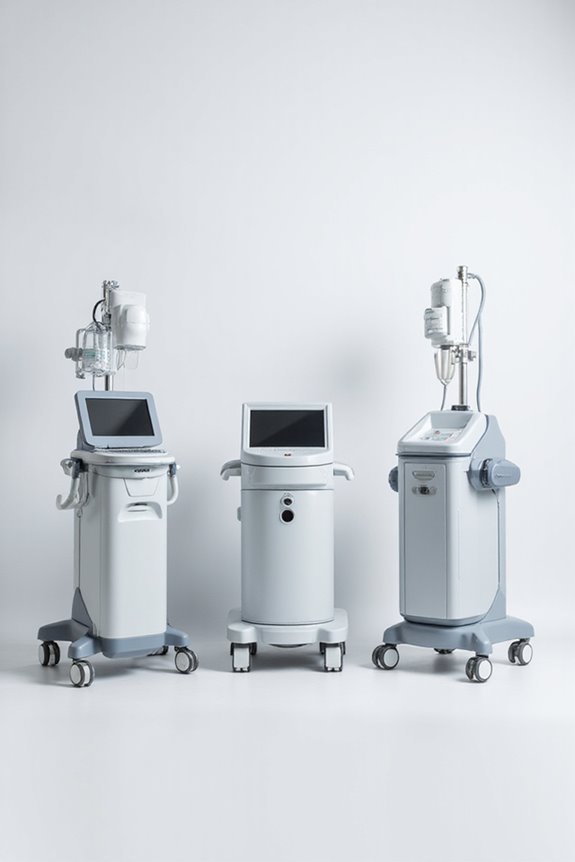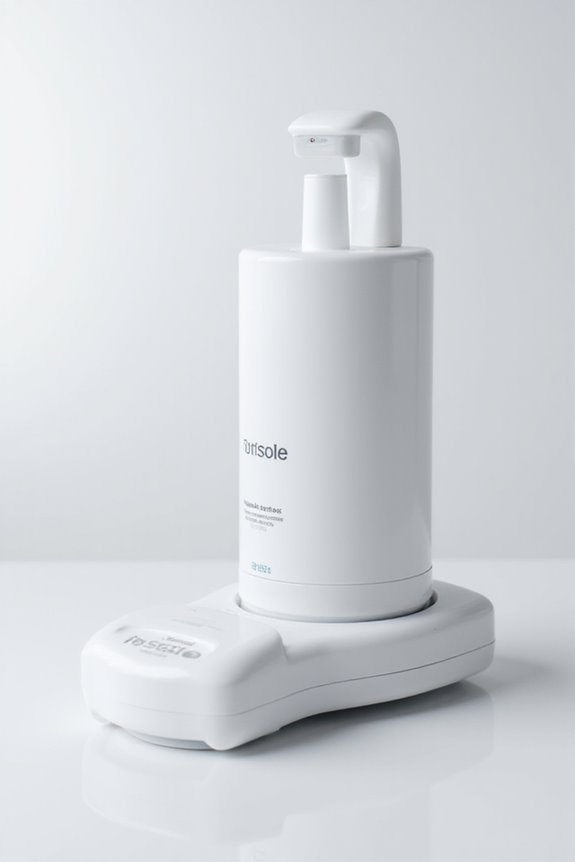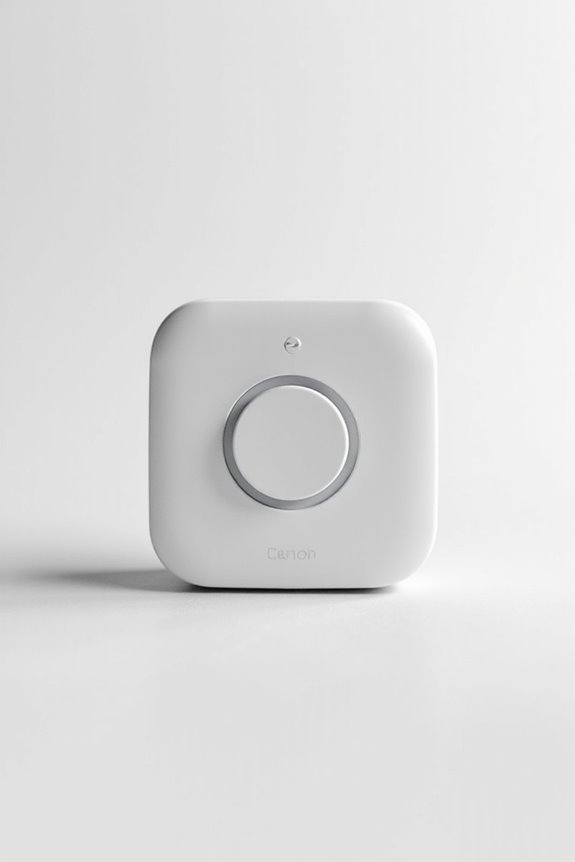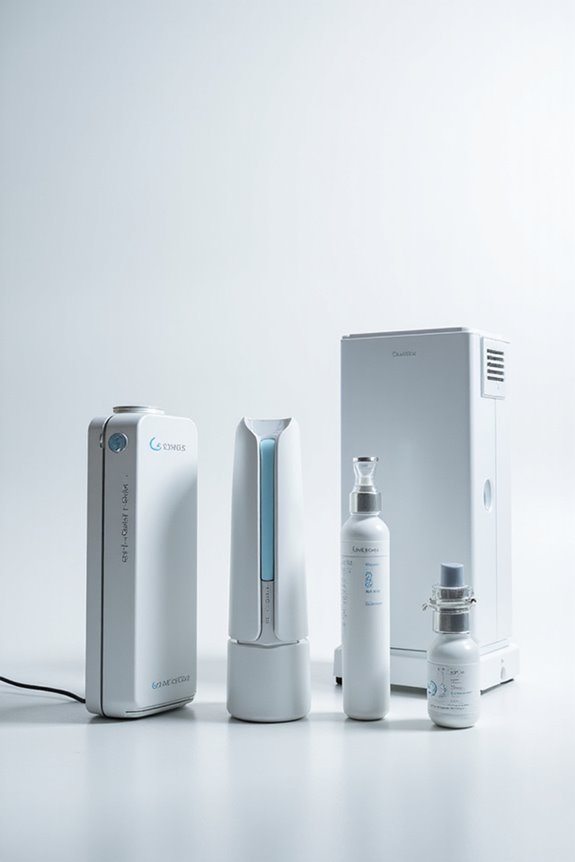Links below are affiliate links. We earn a commission on purchases at no extra cost to you. Although our opinions are based on curated research, we haven't used these products. Articles generated with AI. This article is for informational purposes only and does not constitute medical advice. Please consult a qualified professional for health-related questions.

The 5 Best Flash Glucose Monitors of 2025 – Accurate and Easy to Use
In 2025, the top five flash glucose monitors feature rapid results and convenience:
- OKRA PRO: Home kit with 25 test strips; results in 5 seconds.
- Lingo CGM: Compatible with iPhone, continuous readings for 14 days.
- iHealth Gluco+: Seamless app connectivity, stores 500 readings.
- Riroga: 100 strips and lancets; accurate results in 5 seconds.
- AUVON: Exceeds accuracy standards; data averages available.
These devices vary in features and costs, enhancing diabetes management. Find out more on choosing the best option.
Key Takeaways
- Lingo Continuous Glucose Monitor offers real-time updates and insights on food/lifestyle but requires fingerstick calibrations for accuracy.
- iHealth Gluco+ Wireless Monitor provides seamless data syncing with iOS and Android, storing 500 readings for comprehensive tracking.
- AUVON Blood Glucose Monitor exceeds accuracy standards and includes data tracking averages, despite user concerns about inconsistent results.
- OKRA PRO Blood Sugar Monitor guarantees lab-grade results in just 5 seconds with no coding, making it user-friendly and efficient.
- Riroga Blood Glucose Monitor features advanced accuracy technology and a large display, ideal for quick and reliable monitoring on-the-go.
OKRA PRO Blood Sugar Monitor Kit for Home Diabetes Testing
OKRA PRO Blood Sugar Monitor Kit – 5s Fast Glucose Results, No Coding, Strip Ejection, App for...
- FAST & ACCURATE: Blood sugar (glucose) results in just 5 seconds with lab-grade precision – NO coding or calibration needed.
- STRIP EJECTION: Safe, no-touch removal reduces contamination risk and keeps testing clean and easy.
- APP FOR TRACKING: Visual blood sugar graphs, exportable logs, and history tracking through our glucose monitor app – 100% FREE, no subscription.
The OKRA PRO Blood Sugar Monitor Kit is an excellent choice for individuals seeking a reliable and efficient home diabetes testing solution.
Product Overview
- Kit includes glucose monitor, 25 test strips, 25 lancets, lancing device, control solution, and carry case.
- Provides results in 5 seconds, featuring lab-grade precision with no coding or calibration required.
- No-touch strip ejection guarantees safe and clean testing.
Tracking and App Features
- Accompanying app offers visual blood sugar graphs and logs at no cost.
- Users earn rewards, collecting stars for tests to access refill discounts.
User Experience
– Generally easy to set up and use, with clear instructions provided.
Best For: Individuals seeking an affordable and user-friendly home solution for monitoring blood sugar levels effectively.
Pros:
- Quick results in just 5 seconds with lab-grade precision and no need for coding or calibration.
- Comprehensive app features including visual graphs, exportable logs, and rewards for consistent testing.
- Affordable pricing compared to other blood sugar monitoring solutions, making it budget-friendly.
Cons:
- Mixed customer feedback regarding device functionality and app connectivity issues.
- Challenges with blood sample collection for some users, which may affect testing efficiency.
- Variable customer service response times, leading to potential delays in support.
Lingo Continuous Glucose Monitor (CGM) & App for iPhone 11 or Later
Lingo Continuous Glucose Monitor (CGM) & App. Made by Abbott. Know the impact of what you eat. 1...
- DESIGNED FOR IPHONE 11 DEVICE OR LATER. US Only.
- UNDERSTAND YOUR GLUCOSE HEALTH. The wearable Lingo Biosensor measures your glucose response to food, exercise, and other lifestyle factors. A healthy glucose range...
- A REAL-TIME VIEW OF YOU. See your body’s response with a minute-by-minute view of your glucose. The biosensor streams data to your phone continuously, via Bluetooth and...
For users 18 years and older who are not on insulin, the Lingo Continuous Glucose Monitor (CGM) by Abbott offers an innovative solution tailored for managing glucose levels effectively.
Key Features:
- Device Compatibility: Works with iPhone 11 or later.
- Lifespan: Biosensor lasts up to 14 days.
- Monitoring: Measures glucose response to food, exercise, and lifestyle factors.
- Data Updates: Provides real-time updates via Bluetooth to the Lingo app.
- Application: Easy, painless application with a discreet design.
- User Insights: Logs food and exercise for better health management.
Considerations:
- Calibration: Requires fingerstick calibrations.
- Costs: Subscription model may be perceived as expensive.
- Potential Discomfort: Skin irritation and sensor presence may occur.
Best For: Adults aged 18 and older who are not on insulin and seek to manage their glucose levels effectively.
Pros:
- Provides real-time glucose updates through a user-friendly app.
- Easy and painless to apply with a discreet design suitable for daily wear.
- Allows users to log food and exercise, aiding in healthier lifestyle choices.
Cons:
- Requires fingerstick calibrations, which may limit the convenience of continuous monitoring.
- The subscription model may be considered expensive with ongoing costs for replacing sensors.
- Users may experience discomfort or skin irritation due to the sensor’s presence.
iHealth Gluco+ Wireless Smart Blood Glucose Monitor Kit for Home Use
Sale
iHealth Gluco+ Wireless Smart Blood Glucose Monitor Kit with Free App, 100 Glucometer Strips, 100...
- Effortless Wireless Sync for Anytime, Anywhere Management: Store up to 500 readings in the iHealth glucose monitor kit and access unlimited readings on your iOS or...
- Quick and Gentle Testing in Just 5 Seconds: The iHealth blood sugar testing kit is designed for your comfort and delivers accurate results in 5 seconds with only a tiny...
- Portable and Rechargeable for Easy Blood Glucose Management: The iHealth BG5S100 is a sleek, compact monitor with a dependable, rechargeable battery. For first-time...
- Comprehensive Kit: Includes 100 glucometer strips, 100 lancets, a blood sugar monitor, a lancing device, and a portable carrying case.
- App Compatibility: Works with iOS and Android, allowing storage of up to 500 readings via the free iHealth Gluco-Smart app.
- Quick and Accurate: Delivers results in 5 seconds with a tiny 0.7µl blood sample.
This monitor’s sleek design, user-friendly interface, and built-in alert features enhance your monitoring experience.
Best For: Individuals managing diabetes or those who need to monitor their blood glucose levels for dietary tracking.
Pros:
- Seamless Bluetooth/Wi-Fi connectivity for automatic data storage and access via the app.
- Quick testing time of just 5 seconds with a minimal blood sample for user convenience.
- User-friendly design with adjustable depth settings on the lancet device to minimize pain.
Cons:
- Some users may find the cost of glucometer strips higher without the option to purchase them separately.
- Requires regular charging of the device due to its rechargeable battery.
- Limited compatibility with other health-monitoring apps outside of the iHealth ecosystem.
Riroga Blood Glucose Monitor Kit for Home Use
Riroga Blood Glucose Monitor Kit with 100 Glucometer Strips, 100 Lancets, 1 Blood Sugar...
- 【Advanced glucose monitor kit】: blood sugar testing kit adopts advanced technology. We have passed thousands of repeated tests, clinical tests and laboratory tests,...
- 【Easy to use】: The blood sugar monitor adopts a no coding, which is very simple and easy to use. By correctly inserting the test strip, you can easily perform blood...
- 【0.7 µ l blood within 5 seconds】: The Riroga glucose monitor kit is designed for your comfort, requiring only 0.7 µ l of a small blood sample to provide accurate...
Riroga Blood Glucose Monitor Kit stands out as an ideal choice for those seeking a thorough and user-friendly solution for home glucose monitoring.
Product Overview and Components
- Includes: 1 blood glucose meter, 100 glucometer strips, 100 lancets, 1 lancing device, operation guide, travel case.
- Designed for extensive home monitoring.
Technology and Performance
- Advanced technology guarantees accuracy and reliability.
- Requires only 0.7 µl of blood for results in 5 seconds.
- Stores up to 500 readings.
Ease of Use
- No-coding feature simplifies operation.
- Large display and adjustable lancing device enhance usability.
Portability
– Compact, durable travel case allows for on-the-go testing.
Best For: Individuals seeking an affordable, user-friendly solution for monitoring blood glucose levels at home.
Pros:
- No coding feature makes it easy for users of all ages to operate.
- Fast results in just 5 seconds with minimal blood sample requirement.
- Portable design with a compact travel case allows for convenient on-the-go monitoring.
Cons:
- Limited to 500 readings storage, which may be insufficient for users who test frequently.
- Requires purchasing additional glucometer strips after initial supply runs out.
- The user manual may be too brief for individuals who prefer more detailed instructions.
AUVON Blood Glucose Monitor Kit for Diabetes Testing
AUVON Blood Glucose Monitor Kit for Accurate Test, Diabetes Testing Kit with 100 Glucometer Strips,...
- INSTRUCTIONAL VIDEOS. Insufficient blood applied to test strip will result in wrong readings. Please hold the lancing device firmly against your fingertip for enough...
- EXCEEDS INTERNATIONAL STANDARDS. AUVON BGMs can function within ±10%, or ±10 mg/dl of laboratory values over 95% of the time, which is far beyond ISO 15197:2013 passing...
- CUTTING-EDGE TEST STRIPS. We use cutting-edge test strips enzymes for blood glucose measurements. Our test strips are produced with unique Automatic Carbon Printing...
The AUVON Blood Glucose Monitor Kit stands out as an ideal choice for individuals managing diabetes due to its extensive features and user-friendly design.
Product Components:
- Blood glucose monitor
- 100 glucometer strips
- 100 30G lancets
- Lancing device
Accuracy Standards:
- Exceeds international standards
- ±10% or ±10 mg/dl accuracy over 95% of the time
- CE, GMP, ISO 13485:2016, and ISO 15197:2013 approved
Testing Features:
- Automatic Carbon Printing Technique
- Data tracking with date and time
- Averages over 7, 14, or 30 days
User Support:
- Instructional videos available
- Lifetime warranty and customer service provided
Best For: Individuals managing diabetes who need a reliable, user-friendly blood glucose monitoring solution.
Pros:
- Accuracy: Exceeds international measurement standards with a high level of reliability.
- Comprehensive Kit: Comes with everything needed for testing, including 100 glucometer strips and lancets.
- User Support: Includes instructional videos and lifetime warranty, ensuring assistance and guidance.
Cons:
- Inconsistent Results: Users report variations in readings, leading to potential concerns about accuracy.
- Interpretation of Results: May only be effective for general blood sugar range identification rather than precise measurements.
- Mixed User Feedback: Experiences with the product’s reliability vary among users, creating trust issues for some.
Factors to Consider When Choosing a Flash Glucose Monitor.
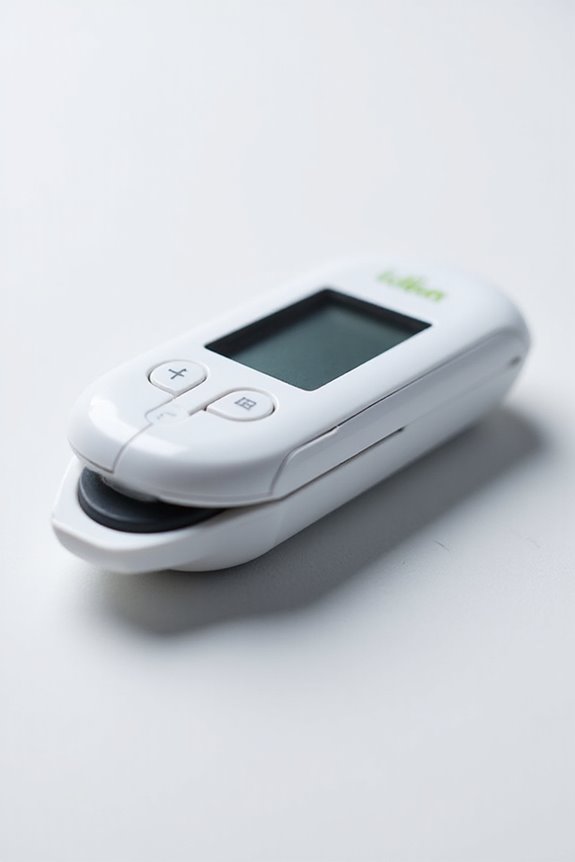
When choosing a flash glucose monitor, it’s crucial to reflect on several critical factors. You’ll want to evaluate the accuracy of readings, user-friendly design, and testing speed. Data syncing options and subscription costs also play significant roles in determining the best fit for your needs.
Accuracy of Readings
How can you guarantee accuracy when selecting a flash glucose monitor?
- Evaluate Standards: Look for monitors meeting ISO 15197:2013 benchmarks, ensuring readings are within ±10% or ±10 mg/dl of laboratory values over 95% of the time.
- Consider Calibration Needs: Recognize that some continuous glucose monitors may require fingerstick calibrations, impacting their perceived accuracy.
- Assess User Technique: Your technique during testing and the quality of test strips can influence precision, leading to variations in readings.
- Analyze Trending Features: Devices offering averaging over periods (7, 14, or 30 days) can enhance trend identification.
- Monitor Discrepancies: Be aware that discrepancies in consecutive readings may occur, with variations up to 30 points potentially complicating effective blood sugar management.
User-Friendly Design
Selecting a flash glucose monitor involves understanding the importance of user-friendly design, as this can greatly influence your daily management of blood glucose levels.
Intuitive Interface
A straightforward, intuitive interface enables you to operate the device without extensive training.
Application Method
A quick, painless application method, such as a spring-loaded applicator, enhances comfort and encourages regular use.
Display Clarity
A clear display is crucial, especially in low-light conditions, allowing for easy viewing of glucose readings.
Instructional Materials
Comprehensive guides should assist users in setup, operation, and troubleshooting, ensuring accessibility for all ages.
Portability
Choose a compact design with a durable case for convenient glucose monitoring on-the-go, accommodating active lifestyles effectively.
User-friendly design is essential for optimal daily management and ease of use.
Testing Speed
Testing speed is a critical factor in choosing a flash glucose monitor, as rapid results allow for timely decisions regarding blood sugar management. Many monitors deliver results in as little as 5 seconds, enhancing user convenience.
Key considerations include:
- Rapid Results: Timely results enable immediate adjustments to diet, exercise, and medication.
- Sample Size: Devices that require smaller blood samples (e.g., 0.7 µl) further expedite testing, making the process less invasive.
- User Compliance: Faster testing can improve compliance, especially for those monitoring glucose multiple times daily.
- Reduced Anxiety: Quickly obtaining results can alleviate discomfort associated with glucose monitoring.
Selecting a monitor with ideal testing speed can greatly enhance user experience and effectiveness in diabetes management.
Data Syncing Options
When evaluating data syncing options for flash glucose monitors, it’s vital to reflect on how effectively the device integrates with your digital lifestyle. Here are key factors to take into account:
- Bluetooth Connectivity: Look for monitors that sync in real-time with smartphone apps, enabling easy glucose tracking.
- Data Exporting: Check if the device supports exporting readings in formats like CSV for seamless sharing with healthcare providers.
- Minute-by-Minute Updates: Choose monitors that provide timely updates to help make informed decisions on diet and activity.
- Logging Features: Make sure the app allows additional logging of food intake and exercise for thorough management of blood sugar.
- Ease of Syncing: Evaluate how easily the monitor connects to the app, as smooth integration enhances user experience.
Subscription and Costs
Understanding the subscription and costs associated with flash glucose monitors is essential for long-term management and budgeting. Here are key factors to evaluate:
- Ongoing Costs: Subscription models often require continuous payments for sensor replacements, which can add up considerably.
- Additional Fees: Some systems charge extra for accessing data or premium features via companion apps, increasing total ownership costs.
- Test Strips and Lancets: Devices with lower upfront costs may still involve recurring expenses for necessary test strips and lancets.
- Value-Added Benefits: Assess if subscription services provide discounts on supplies or enhanced app features.
- Insurance Coverage: Explore potential insurance reimbursement options to better understand long-term financial impacts.
Compatibility With Devices
Compatibility with devices plays a critical role in selecting the right flash glucose monitor, as it determines accessibility and ease of use.
- Confirm the monitor is compatible with your smartphone model to optimize convenience.
- Many monitors utilize Bluetooth technology to connect with mobile apps, enhancing real-time glucose data tracking.
- Verify that your operating systems and app versions align with the monitor’s requirements for seamless functionality.
- Assess any age restrictions or specific user conditions tied to certain monitors, as some devices cater to particular demographics.
- Check the app’s data export capabilities; compatibility with other health management tools is crucial for thorough tracking and analysis.
Frequently Asked Questions
How Do Flash Glucose Monitors Differ From Traditional Blood Glucose Meters?
Flash glucose monitors differ from traditional blood glucose meters primarily in how they measure and display glucose levels.
- Continuous Monitoring: Flash monitors provide continuous glucose readings without finger pricks.
- Data Usage: They store data for analysis, offering trends over time.
- User Interaction: You scan the sensor to get real-time readings, unlike traditional meters that require a blood sample.
These differences enhance usability, convenience, and data management for users.
Are Flash Glucose Monitors Covered by Insurance Plans?
Flash glucose monitors may be covered by various insurance plans, but coverage varies considerably.
- Medicare: Generally offers coverage for certain continuous glucose monitoring systems.
- Private Insurance: Some plans may cover flash glucose monitors, contingent upon medical necessity.
- Out-of-Pocket Costs: Without insurance, users may incur considerable expenses.
It’s advisable to consult with your healthcare provider and insurance provider for precise coverage details tailored to your situation.
Can I Use a Flash Glucose Monitor While Exercising?
Using a flash glucose monitor during exercise is akin to having a map while traversing unfamiliar territory. You can efficiently track your glucose levels, ensuring safe activity.
- Accuracy: Monitors provide real-time data.
- Safety: Stay aware of potential hypoglycemia.
- Convenience: Quick scans allow for easy access even while active.
How Often Should I Replace the Sensor in a Flash Glucose Monitor?
You should replace the sensor in your flash glucose monitor every 14 days.
Key points:
- Sensors are typically designed for a two-week wear.
- Replacing the sensor timely guarantees accurate glucose readings.
- Using a sensor past its intended duration may lead to unreliable data.
Adhering to this schedule helps maintain the device’s reliability and efficacy in managing your glucose levels effectively. Regular monitoring is critical for peak health management.
Do Flash Glucose Monitors Require Calibration With Fingerstick Tests?
Flash glucose monitors typically don’t require calibration with fingerstick tests, as they’re designed for accurate and continuous glucose monitoring. However, some models may recommend occasional fingerstick checks for accuracy verification.
Key Points:
- Most users find them reliable without calibration.
- Manufacturer guidelines may suggest fingerstick verification under certain conditions.
- Always follow the instructions specific to your device.
Stay informed to guarantee ideal use and accuracy in your glucose management.






